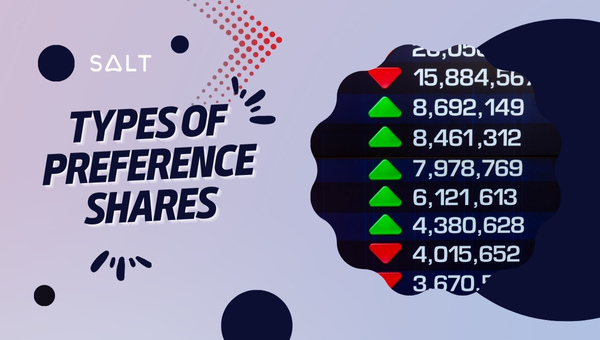Preference Shares vs Ordinary Shares In 2024 [Complete Guide]
Understanding Preference Shares vs Ordinary Shares can be a daunting task. Preference shares are often seen as more complex than ordinary shares, but with the right guidance, you can learn to navigate them successfully.
This blog post will explain the key distinctions between these two types of investments so that you can make smart decisions about your portfolio. We'll discuss topics such as rights and privileges, voting power, dividends, and liquidation preferences in order to give you a comprehensive understanding of preference vs ordinary share investing.
By the end of this article, you should have a much better grasp on which type of investment is best suited for your goals!
Skip Ahead
What Is Preference Shares?

Preference shares also referred to as preferred stock, are a type of security issued by a company that enables investors to take advantage of certain rights and advantages over ordinary shareholders.
Preference shares act similarly to debt securities in that they offer the investor a schedule of fixed dividend payments and priority in case of the sale of assets or liquidation of the company. They have a higher claim on dividends and assets than ordinary shares, making them attractive investments for those seeking returns with some assurance.
Offering these shares can also benefit companies since it gives them access to additional funds without needing to take out loans or issue bonds. Preference shares are typically classified into cumulative and non-cumulative categories depending on whether the dividend can be deferred.
As such, investors must carefully weigh their options when considering whether to invest in preference shares or ordinary stocks.
What Are Ordinary Shares?

Ordinary Shares are a financial instrument that gives the investor a stake in the company. Ordinary shares entitle holders to vote on critical corporate decisions, participate in dividend distributions, and potentially benefit from capital appreciation of their shares.
This type of stock is typically riskier than preference shares since holders do not have any claim on assets or dividends until all other creditors are paid out. Ordinary shareholders have voting rights.
Ordinary Shares represent an equity interest in a business, meaning profits are shared through capital appreciation or dividends depending on their ability to make profits. Ordinary Shares usually do not carry fixed dividend yields like Preference shares.
Still, Ordinary Shareholders benefit when there is long-term growth within a company because they get higher capital gains on their Ordinary Shares than Preference shareholders.
It's important to remember that Ordinary Shares have no set time frame and may be held for years or even decades, providing steady returns over time.
Ordinary shares are the most common share issued by a company and represent the primary form of ownership. This Shares also allow holders to receive capital gains when sold on the stock market at a higher price than purchased. Companies may choose to issue preference or ordinary shares depending on their size and complexity.
How Are Preference And Ordinary Shares Different?

These are some differences between Preference and Ordinary shares.
Preference Shares -
Preference Shares are used by companies to raise capital that comes with an entitlement to fixed dividends.
Preference Shareholders do not have voting rights on the company’s operation.
They can't make decisions regarding the company’s direction or strategy.
Preference Shareholders are not eligible for any additional incentive shares from the firm.
Ordinary Shares -
Ordinary Shareholders have voting rights on corporate decisions and can receive dividends when declared by the company. There is no fixed dividend payment amount, and dividends are not guaranteed.
Ordinary Shareholders can receive capital appreciation when their shares are sold at a higher price than purchased on the stock market.
Ordinary shareholders may be eligible for additional incentive shares from the firm, depending on the company's performance or other factors.
Types Of Preference Shares

The different types of preference shares are:
- Cumulative Preference Shares: These shares entitle the holder to an accumulated dividend if the company fails to pay them at the promised dates.
- Non-Cumulative Preference Shares: These shareholders are entitled to a missed dividend only if and when it is paid by the company.
- Participating Preference Shares: Such shares entitle the holders to a fixed dividend and give them the right to participate in the company’s profits.
- Non-Participleating Preference Shares: These shareholders do not have the right to participate in the company’s profits.
- Convertible Preference Shares: These are convertible into ordinary shares at specific dates or the discretion of the board of directors.
- Non-Convertible Preference Shares: These shares cannot be converted into ordinary shares.
- Redeemable Preference Shares: These preference shares can be redeemed at a specific date or the board's discretion.
- Non-Redeemable Preference Shares: These preference shares cannot be redeemed.
Types Of Ordinary Shares

Here are some types of ordinary shares:
- Right shares: These are the shares issued to existing shareholders in proportion to their holding.
- Issued shares: These are those issued by a company to anyone other than its existing shareholders.
- Subscribed shares: These are those issued to shareholders who have subscribed for them.
- Sweat equity share: These are the most common type of ordinary share with voting rights and variable returns depending on the performance of a company.
- Bonus shares: These are issued to the existing shareholders without charging any price or payment.
- Treasury shares: These are the shares that have been repurchased or bought back by the company from its shareholders.
Who Issues Preference Shares?

Basically, the high-ranking officials in a company, such as the Board of Directors, Promoters, or Founders, can issue preference shares when they want to raise capital.
The issue and allotment of preference shares are regulated by the Companies Act and other regulations applicable in different countries.
Who Issues Ordinary Shares?

The board of directors has the authority to issue ordinary shares for the purpose of raising capital or diluting ownership among different stakeholders. They may also issue new shares to existing shareholders as a bonus for employee stock options or other reasons.
Ordinary shares can be issued through an Initial Public Offering (IPO), where shares are offered to the public. Also, private placement is another method of issuing ordinary shares, which involves selling the securities to one or more institutional investors, such as venture capitalists or hedge funds.
The board also has the authority to issue special classes of shares, such as non-voting and restricted voting shares, with limited rights attached to them. Sometimes, a company may issue stock options or warrants to its employees.
Preference Shares Vs Ordinary Shares: Which One Is Better?

There is no perfect answer to this question, as it depends on the individual investor’s risk appetite and personal goals.
Preference shares offer greater security and stability than ordinary shares because they provide regular income in the form of dividends throughout the life of the investment.
On the other hand, ordinary shares may provide higher returns if a company performs well but also come with a greater risk of loss due to fluctuations in the stock market.
Therefore, it is important for investors to understand their own investment goals and risk profile before deciding which type of share to invest in.
Both preference shares and ordinary shares can be viable investments depending on the individual’s personal circumstances.
FAQ About Preference Shares vs Ordinary Shares:
What is one important difference between an ordinary share and a preference share?
The main difference is that preference shares offer priority to dividends over ordinary shares and to a return of capital when the company goes into liquidation.
What types of ordinary shares are there?
The most common types of ordinary shares are right shares, issued shares, subscribed shares, sweat equity shares, bonus shares, and treasury shares.
Who can issue preference or ordinary shares?
Preference shares are typically issued by high-ranking officials in a company, such as the Board of Directors, Promoters, or Founders. Ordinary shares may be issued through an Initial Public Offering (IPO) or private placement.
What is the best type of share to invest in?
The best type of share to invest in depends on an individual’s risk appetite and personal goals. Preference shares offer greater security and stability, while ordinary shares may provide higher returns if the company performs well.
Ultimately, investors should decide which type of share to invest in based on their own circumstances.
Is preference share high risk?
Preference shares generally have a lower risk than ordinary shares, as they prioritize dividends and return of capital when the company goes into liquidation. However, investors should consider any other risks associated with investing in either type of share.
Conclusion
Understanding Preference shares vs ordinary shares are both excellent investments that may suit different investors' needs. Preference shares provide a steady stream of income, while ordinary shares offer the potential for higher returns if the company performs well.
However, investors must understand their own risk profile before determining which type of share to invest in. It is important to remember that there is no one-size-fits-all solution to investing; what works best for one person might not be appropriate for another.
Ultimately, by taking the time to research and evaluate your investment goals, you can make an informed decision on whether preference or ordinary stock is right for you.

Michael Restiano
I support product content strategy for Salt Money. Additionally, I’m helping develop content strategy and processes to deliver quality work for our readers.
